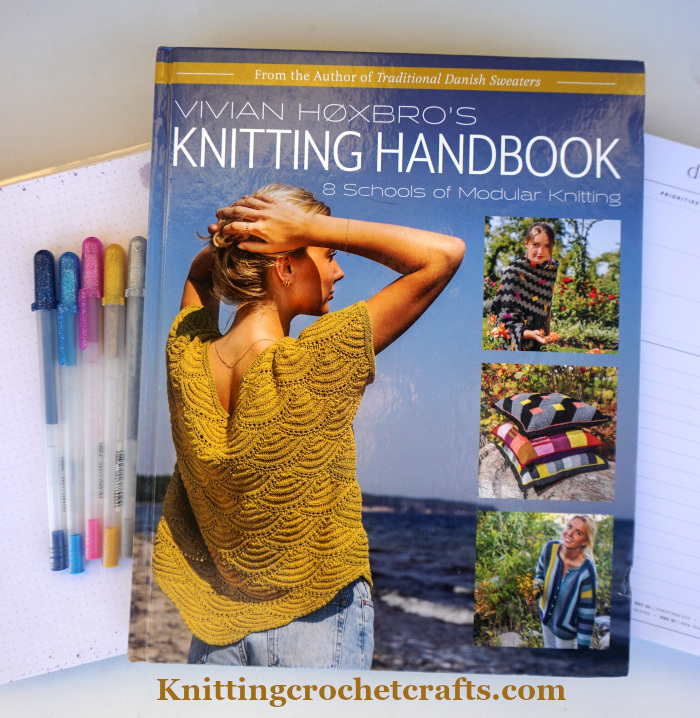
This is a book review of Vivian Hoxbro’s Knitting Handbook:8 Schools of Modular Knitting
What You Need to Know About This Knitting Pattern Book:
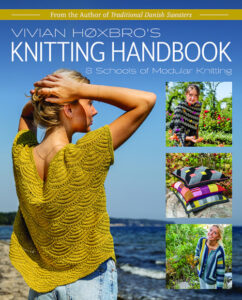
Author: Vivian Hoxbro
Publisher: Trafalgar Square Books
Copyright Date: I am reviewing the English language translation of this book, which has a copyright date of 2022. This book was originally published in 2021 in the Danish language with a title of Finurlig Strik.
ISBN 13: 9781646011353
ISBN 10: 164601135X
Book Format: This is a hardcover book without dust jacket. The photographs and diagrams are printed in full color.
Number of Pages: 188
Recommended Knitting Skill Level: Many of the patterns in this book are fairly easy ones. I recommend this book to total beginners and also to knitters of other skill levels who would like to learn more about modular knitting, mitered knitting, how to knit entrelac patterns, how to knit circles, etc. If you don’t yet understand how to knit in any direction other than starting at the bottom and working your way up, you are likely to learn a massive amount from reading this book. But if you are already knowledgeable about how to knit mitered squares, entrelac, circles, etc, please be aware that this book might not teach you anything new.
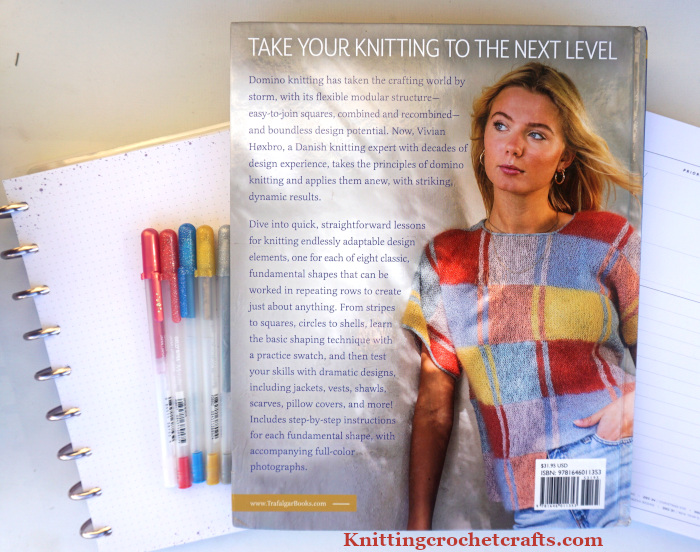
The Focus of This Book:
Modular knitting is the focus of this book. The author, Vivian Hoxbro, has divided the book into 8 “schools”, each covering a different way of constructing modular knitted designs.
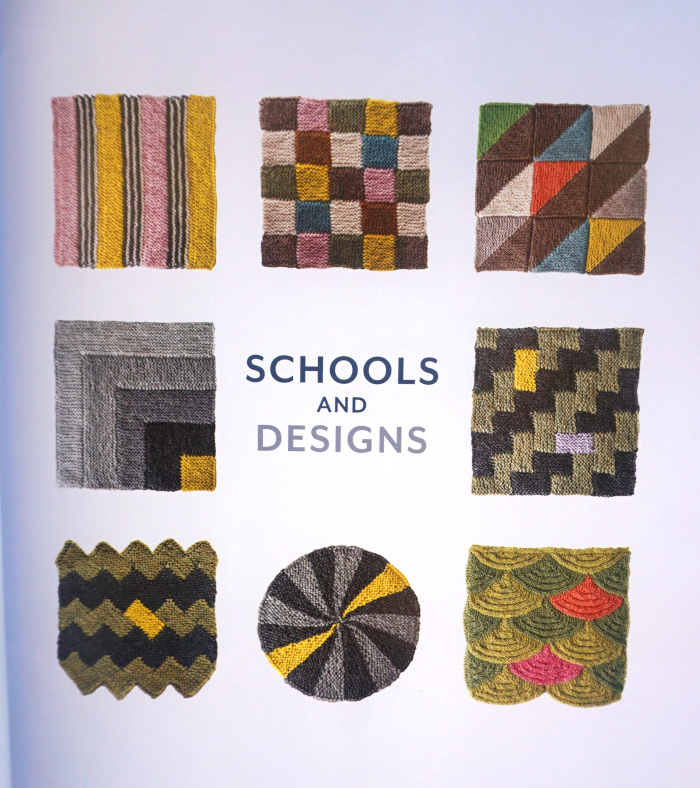
The schools are as follows:
- Stripes
- Squares (and entrelac knitting)
- Tri-Squares
- Right Angles
- Staircases
- Zigzag
- Shells
- Circles
This portion of the book covers pages 14-162.
The rest of the book is devoted to teaching you knitting techniques and giving you simple knitted edging patterns. Techniques covered include casting on, decreasing, changing colors, weaving in ends, binding off, picking up and knitting stitches, increasing and other basic techniques.
Knitting Projects Included in This Book:
1. Triangular Shawl
This triangle shawl is quite lovely, and it looks like it would be an interesting project to work on. The design incorporates both stripes and triangles, and the variegation in the suggested yarns adds even more visual interest to the project.
2. Spiral Top
This top is amazing. It is asymmetrical and distinctive, and its construction is significantly different than your typical sweater pattern. It’s named the “spiral top” because it’s knitted in one long strip that you shape into a spiral as your work progresses. The spiral isn’t particularly evident when you look at a photo of the top; it looks a lot more like knitted blocks.
3. Reddish Pillow Top
4. Checkerboard Vest
5. Viking Coat
6. Boxes Pillow Cover
7. Right-Angle Pillow Cover
8. Right-Angle Jacket
9. Marie Grubbe Long Shawl
10. Staircases Jacket
11. Zigzag Vest
12. Zigzag Poncho
13. Wing Shawl
14. Shell Top
15. Boomerang Shawl
16. Snake Scarf
The Best Things About This Book
The patterns in this book are really clever and innovative, without being overly complex. It takes a certain genius to design knitting patterns that are interesting but still reasonably easy – and that is this book’s primary strength, in my opinion.
The book includes gorgeous, glossy, full-color photos that show off each project beautifully.
The explanatory material in this book includes many clear step-by-step and work-in-progress photos, empowering you to understand each concept intuitively.
Full-color diagrams are included where appropriate to help you understand how each project is constructed.
The book includes a mix of projects; some are wearable and others are home décor projects / pillow covers. If you are a beginner to knitting, I recommend making the pillow covers first because they don’t have to fit anyone precisely, which makes them more forgiving of gauge mistakes if you happen to make any of those. A pillow cover will still be usable even if it’s an inch or two larger or smaller than you were expecting it to be – whereas a sweater could end up being unwearable if it’s a few inches too small, or possibly even if it’s a few inches too big, depending on the design and intended fit.
Other Observations About This Book
The author has mentioned the original yarn(s) used for knitting each of these projects and has also recommended a suggested yarn weight on the Craft Yarn Council’s yarn standard system.
These projects were originally knit in European yarns. I was able to locate some of them from suppliers in North America, but since supplies of these might be limited, I believe it is likely that you will need to make yarn substitutions when you make many of these projects. Happily, the team at Trafalgar Square Books has made this very easy to do; you’ll be able to tell at a glance from each pattern if you need to use a lace weight yarn, a fingering weight yarn, a sport weight yarn or a light worsted weight yarn.
These patterns are knitted using small needles. If you are used to using larger needles, I’d advise you to allocate more time for these projects than you’re used to spending.

The projects presented in this book are predominantly knitted in a color palette of drab grays, soothing blues, placid greens, vivid, vibrant golden tones and lovely reds. If these colors do not appeal to you, I encourage you to use different yarn colors when you knit these projects for yourself.
Other reviewers have mentioned that this book has multiple small errors in it. I haven’t yet actually knitted any of the patterns in the book to confirm this but wanted to mention that it might be an issue. I will update this review if I notice any errors after having knitted projects in the book. As of this review’s posting date, I am still working on figuring out which yarn(s) I want to order and which projects from the book I’d like to make.
Conclusion
Overall, I believe this book is truly helpful and does an outstanding job of presenting the concepts of modular knitting. I’m delighted to recommend this book to other knitting enthusiasts, particularly to beginning knitters or to knitters who don’t already have a solid understanding of concepts like how to do entrelac knitting, how to knit circles, or how to knit in directions other than starting at the bottom and working your way up.
If you’re already well versed in Entrelac knitting, circular knitting, mitered knitting, and similar modular knitting techniques, the explanatory material in this book isn’t likely to teach you anything new; in that case, I’d still recommend the book to you if you are interested in having these particular patterns.
Where to Buy This Book:
More From This Author
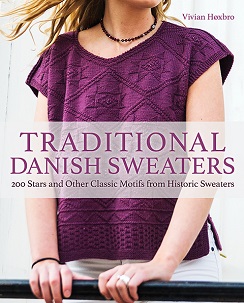
Vivian Hoxbro has written many other lovely knitting books. I had the pleasure of reading and reviewing a previous book of hers called New Knitting Patterns for Traditional Danish Sweaters. The short version of the review: I highly recommend the book! You can click or tap here to find my review of this title.
Thanks for checking out this knitting book review. I appreciate your interest!
An Invitation to Receive My Craft Newsletter
I invite you to return to this site often for more knitting book reviews, craft tutorials, project ideas and inspiration! You can make sure you keep this site on your radar by signing up for my newsletter and community at Substack. .
Basic subscriptions are free; I send out regular newsletters to let my subscribers know about new craft articles and tutorials as they are posted. I also share details about the craft projects I’m working on, and invite my readers to share their projects, too. So there is no need to feel like it’s just you, crafting all alone at home. I’d love to have you join us! You’re invited!!
Posted By: Amy Solovay
Please Visit My Ko-Fi Shop HERE to Find My Sample Sale, Destash Sale and Digital PDF Pattern Downloads for Sale.
Please Visit My Ravelry Store HERE to Find Digital PDF Pattern Downloads for Sale.
About the Author:
Amy Solovay is a real, live, human content creator and educator who holds an Associate of Arts degree in Textile Design from FIDM LA (The Fashion Institute of Design and Merchandising, Los Angeles) and a Bachelor of Arts degree in mathematics from Sweet Briar College. She is NOT a robot and does not use artificial intelligence (AI) to write book reviews or articles for this website.
Amy learned to hand knit as a teenager, and she learned to machine knit in design school at FIDM. After graduation, she worked in the textile industry as a professional knit designer. She still enjoys hand knitting all these years later.
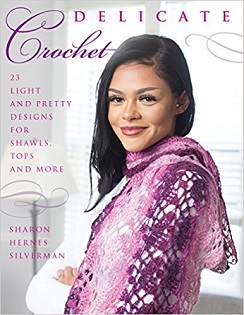
As an educator, Amy Solovay used to teach in-person college courses in trend forecasting, marketing and surface design at California Design College in Los Angeles. Nowadays she uses online platforms for sharing her knowledge about textiles, crafts, current color trends and current design trends.
Find More Knitting Technique Books
- Lace Knitting — If you’d enjoy knitting lovely, ethereal projects that incorporate lacework patterns, this is the book for you! I think the projects in this book are exquisite!
- Cable Knits from Nordic Lands
- Dimensional Tuck Knitting — This book is really amazing and is definitely worth the click if you’d be interested in learning how to knit highly dimensional, textured fabrics.
- Click here to find my picks for 2026’s best new knitting books.
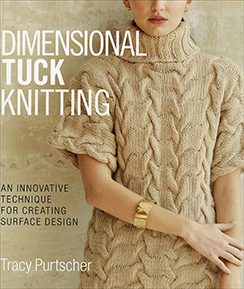
This page was last updated on 11-8-2025.
